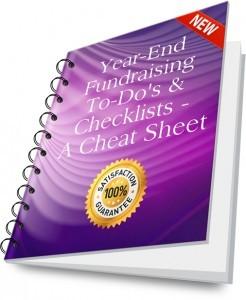The end of the calendar year is fast approaching. This is the time when your annual fundraising goals will likely be met, surpassed or put onto life support. Because even if you operate on a fiscal year, now is the time when most people do most of their annual giving. So make sure to get all your ducks in a row with these 13 lucky tips (REMEMBER: You do have to make your own luck. As management guru Peter Drucker says: The best plans are only good intentions, unless they degenerate into work.).
13 Year-End Tips for Luck!
- Send Impact Reports to Set the Stage
Your objective: Make past donors feel inclined to give again. If you’ve not done so already, send a report to remind donors of their past decision to give to your cause and show how they helped. Humans are inclined to repeat past decisions to show their consistency.
- Establish Goals Based on Last Year’s Results
Your aim: To set realistic, measurable objectives. Otherwise you won’t know if you did a poor job, a status quo job or a “hit it out of the ballpark” job. Look at retention, upgrades and downgrades from last year and evaluate your areas for improvement.
- Prioritize Contacts with Your Most Promising Supporters
The point: Pay special attention to your existing supporters, and don’t become so focused on acquiring new donors that you forget it’s much easier and more cost-effective to renew a donor than to acquire one. Make donor retention and upgrading a priority.
- Build Your Donor-Centered Case for Support
Your overarching goal: You absolutely must have a compelling reason for people to support you – right now. Always ask: What’s in this for the donor? How do they benefit by giving here? How can we demonstrate we’re relevant to their lives? To what they’re thinking about and caring about? And… don’t forget to include a clear, persuasive call to action.
- Optimize Your Website
This is the foundation of your nonprofit’s online presence. 82% of donors report visiting a nonprofit website prior to making a gift. Make sure they find what they’re looking for, and make it easy for them to take action.
- Build Compelling Donation Landing Page(s)
Your method: Visitors who are directed to a landing page are 10X more likely to give than visitors who start on a home page. Wherever folks come from (email, hard copy appeal, social media, blog post, organic search), you want people to go to a page where they’re compelled to take action!
- Plan a Multi-Channel Campaign
The point: Make your hard work do double and triple duty. Don’t waste all that thought and energy you put into your mail appeal. Reinforce and leverage your efforts by spreading your message through multiple channels.
- Plot Your Year-End E-Appeal Series
Your objectives: Assure you ‘cash in’ during the final month of the year when such a large percentage of annual giving occurs – with the big spike coming in the final few days. Plan to send enough emails to maximize your chances (three between December 26 and January 31 is recommended, with two to four additional in the weeks between Thanksgiving and Christmas).
- Incorporate Peer-to-Peer (P2P) Fundraising
Your consideration: Studies show peer-to-peer fundraising is on the rise, and well worth your serious consideration, ranging from 23% to fully one-third of all online fundraising (see here and here).
- Share Your Campaign on Social Media
Your objectives: To (1) Reinforce the message in your appeal letter and e-appeal; (2) Send folks to your website home page and donation landing pages using links; (3) Spread the word to new prospects using advocates and influencers, and (4) Predispose prospects to give by building your brand and sharing your impact.
- Boost response with follow-up calls and notes to lapsed donors
Your objective: Remind donors of previous giving, thank them for their past support and tell them you miss them! These reminders act as a decision-making shortcut for donors.
- Offer Stellar Year-End Donor Service
Your process: Have someone in the office who can answer donor inquiries during the last week of the year! If you’re not going to be fully staffed during the last week of the calendar year (say you’re a school, and everyone takes vacation), plan ahead for how you’ll handle donor inquiries around making donations.
- Build Your Acknowledgment Plan
Your goal: Set up the donor’s next gift with a stellar donor love and loyalty program. Write thank you’s for different donor segments and dollar amounts. Align the copy with the messaging in your appeal. Assure you have systems in place to get all thank you letters out promptly.
Want more actionable year-end advice?
 Grab my Year-End Fundraising Solution Kit — your all-in-one guide for ticking off the things you may be missing or may not quite have finished. You’ll find a ton of practical tips, great examples and useful checklists! I dare you not to find at least one tip that will raise WAY more additional money than what you invest in this 63-page e-guide (don’t forget, you receive a generous discount as a member of Clairifcation School). And if you’re not happy, all Clairification products come with my 30-day no-questions-asked 100% refund guarantee. You’ve nothing to lose, and much to gain.
Grab my Year-End Fundraising Solution Kit — your all-in-one guide for ticking off the things you may be missing or may not quite have finished. You’ll find a ton of practical tips, great examples and useful checklists! I dare you not to find at least one tip that will raise WAY more additional money than what you invest in this 63-page e-guide (don’t forget, you receive a generous discount as a member of Clairifcation School). And if you’re not happy, all Clairification products come with my 30-day no-questions-asked 100% refund guarantee. You’ve nothing to lose, and much to gain.